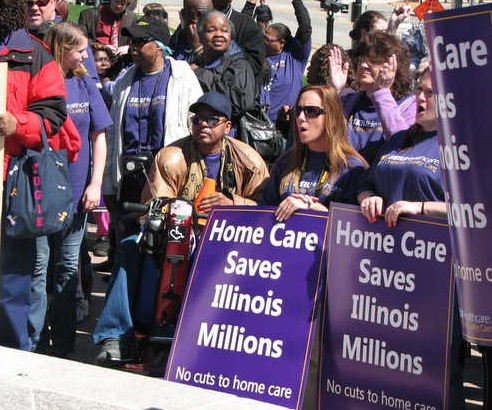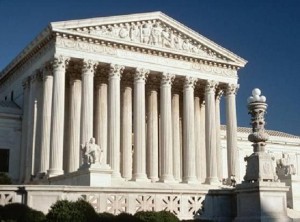
– Daily Kos photo
Does not impact public, private sector workers but will it open the door?
By Mark Gruenberg
Editor PAI News Service
Washington (PAI) – In a narrowly-targeted decision that will rob caregivers across America of the right to have a strong union, the U.S. Supreme Court voted 5-4 to legalize “free riders” in cases where states and/or local governments, together with individuals, jointly employ home based caregivers. The court ruled that in these cases, the caregivers are only partial public employees.
The ruling thus does not effect public employees or private sector workers, although lawyers for the National Right To Work Legal Defense Fund, who funded the lawsuit, made it clear in oral arguments that destroying unions, in public agencies and in private enterprise, by yanking all dues is his group’s ultimate goal. He even said so to Justice Antonin Scalia in court.
The court split along partisan lines, with all five Republican-appointed male justices in the majority and the four other justices – Elena Kagan, Stephen Breyer, Ruth Bader Ginsburg and Sonia Sotomayor – dissenting.
Justice Samuel Alito’s majority opinion in this case — Harris vs. Quinn involving home-based caregivers from Illinois — said Illinois violated the workers’ First Amendment rights to free speech by requiring them to pay “agency fees” – money to cover costs of collective bargaining and contract administration from which they benefit – to the Service Employees, the union a majority of the workers voted by secret ballot to have represent them.
“A state may not force every person who benefits from this group’s efforts to make payments to the group,” Alito said, totally ignoring the fact that federal law requires the union represent everyone in the bargaining group, members and non-members alike.
‘MASS EXODUS’ PREDICTED

At least 20 other states and local governments have similar arrangements where government workers whom the union must represent by federal law, but who do not wish to join, must pay agency fees, Kagan’s dissent noted.
She predicted there could be a mass exodus from the unions, not just of the agency fee payers, but also of members.
The laws of economics, letting them be free riders while still compelling unions to represent them, would lead to those departures, she predicted.
“…after all, (why) should that endemic free-riding be surprising? Does the majority think that public employees are immune from basic principles of economics? If not, the majority can have no basis for thinking that absent a fair-share clause, a union can attract sufficient dues to adequately support its functions.”
Latest data show the U.S. has 1.14 million personal care aides and 807,000 home health care aides. Women are an overwhelming majority of the affected workers.
SEIU STANDS FIRM
SEIU commented immediately after the ruling:
“The ruling places at risk a system of consumer-directed home care in Illinois that has proven successful in raising wages, providing affordable health care benefits, and increasing training,” SEIU President Mary Kay Henry said.
Putting an optimistic face on the ruling, she added: “No court case is going to stand in the way of home care workers coming together to have a strong voice for good jobs and quality home care.
“At a time when wages remain stagnant and income inequality is out of control, joining together in a union is the only proven way home care workers have of improving their lives and the lives of the people they care for.”
TORTURED REASONING
In his tortured reasoning for the majority, Alito ignored economic realities of “Why pay for something when you can get it for free?” pointed out by Justice Kagan. Said Alito: “Given that Illinois’ caregivers voted to unionize, it may be presumed that a high percentage became union members and are willingly paying union dues.”
Kagan, politely, doubted that.
“In fact nothing of the sort may be so presumed, given that union supporters (no less than union detractors) have an economic incentive to free ride,” she responded.
TWO EMPLOYERS
Alito explained that “partial public employees” – the caregivers – have two employers: The state and the elderly or disabled individual they care for. A state law to have free riders pay the fair share costs of the SEIU-negotiated agreement, which covers all caregivers – though the state sets their wages and benefits – is unconstitutional because the fair share payment breaks the dissenting workers’ free speech rights, Alito alleged.
DOES NOT IMPACT PUBLIC, PRIVATE SECTOR EMPLOYEES
The anti-worker, anti-union National Right To Work Legal Defense Fund recruited the complaining caregivers and funded their case. It wanted the justices to go even further and reject union dues for all public workers in all cases, but Alito turned that down.
The caregivers “are quite different from full-fledged public employees, (so) we refuse to extend” past decisions about agency fee-payers “to the new situation now before us,” Alito said. ““Extending those boundaries to encompass partial-public employees, quasi-public employees, or simply private employees would invite problems.
“A joint employer remains an employer,” Kagan responded. “Illinois kept authority over all workforce-wide terms of employment – the very issues most likely to be the subject of collective bargaining. The state thus should also retain the prerogative…to require all employees to contribute fairly to their bargaining agent,” she retorted.
SILVER LINING
Kagan did find one silver lining: Rejection of the right-to-work group’s scheme to declare all public agencies as open shops, with no requirement for union dues from anyone in any enterprise, public or private.
“The good news out of this case is clear: The majority declined that radical request,” Kagan said.
“The court did not, as the petitioners” – the right-to-work group – “wanted, deprive every state and local government, in the management of their employees and programs, of the tool that many have thought necessary and appropriate to make collective bargaining work.
“The bad news is just as simple: The majority robbed Illinois of that choice in administering its in-home care program.”
(PAI’s has been modified by the Labor Tribune staff.)

